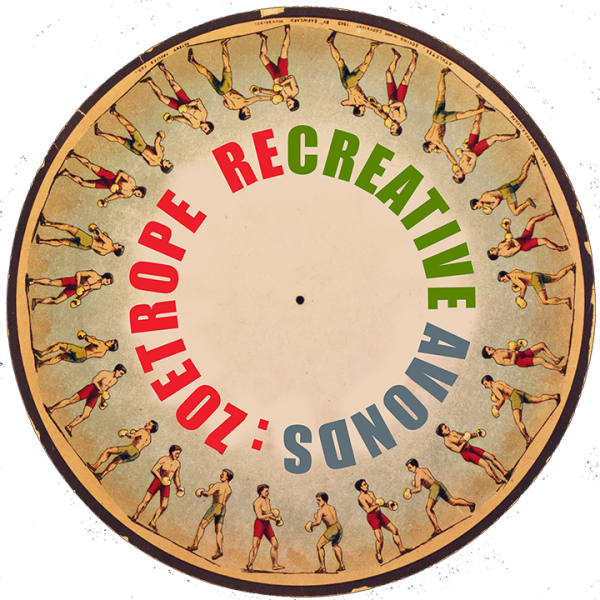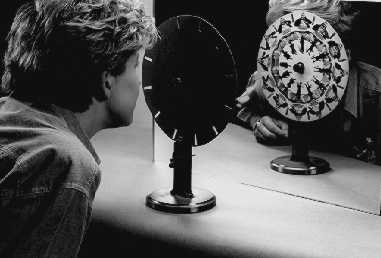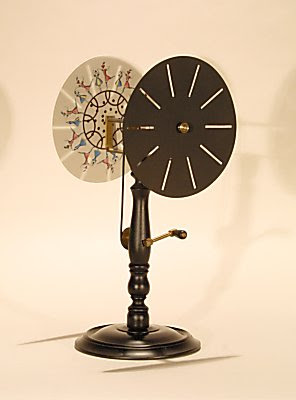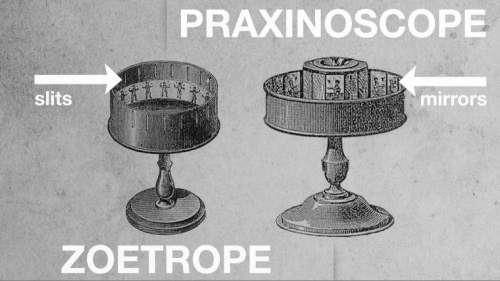Difference between revisions of "Animation: History, resources, and other good stuff"
| Line 113: | Line 113: | ||
Peter Hudson | Peter Hudson | ||
[https://www.youtube.com/watch?v=WCyEvpyscYA huge scale 3d zoetropes at Burning man - this is the man] | [https://www.youtube.com/watch?v=WCyEvpyscYA huge scale 3d zoetropes at Burning man - this is the man] | ||
| + | <br> | ||
| + | <br> | ||
| + | [https://www.youtube.com/watch?v=RjSxrVXsfVM Disney's toy story 3d zoetrope] | ||
=Potentially useful re-creative technology= | =Potentially useful re-creative technology= | ||
Revision as of 02:32, 5 January 2015
Pre-cinematic animation devices
History
Animation - as we might understand it as a technical process of synthesising motion from a series of static images - precedes the invention of the cinematograph by several decades. It has its roots in the numerous game toys / devices, popular in the early 1800s which experimented with persistence of vision effect known as the Phi phenomenon.
Thaumatrope
The Thaumatrope accredited to three different people, Dr Fitton of London, Peter Roget and London physicist John Ayrton Paris. However it is known that Paris used his device to show the Phi phenomenon to the Royal College of Physicians in 1824. Its consisted of a disc with an image painted on each side. When the disc was spun by pulling on a twisted pair of strings, the images seemed to be combined - a bird on one side of the disc would appear in the empty cage on the other side. 'Trope' comes from the Greek word for 'things that turn'. 'Thauma' means wondrous, therefore a thaumatrope is a 'turning marvel' or 'wonder turner'.
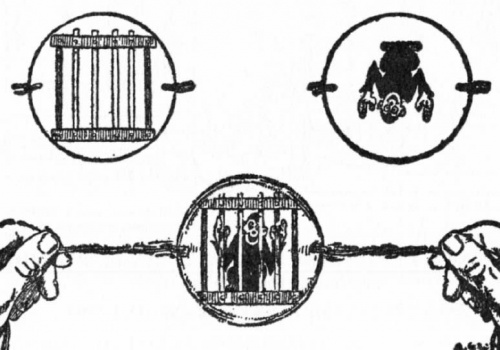
LINKS - - - - - >
how it works
Phenakistiscope and Stroboscope
In 1832 Joseph Plateau (Ghent, Belgium) coined his invention - the Phenakistiscope (Greek for 'deceptive view'). That same year, professor Simon Ritter von Stampfer of the Polytechnical Institute (Vienna, Austria) developed the Stampfer Disc (also called the Stroboskopische Sheiben, Stroboscope Discs, optical magic disc, or simply Stroboscope ). Essentially, this was the same device as Plateau's phenakistiscope. These devices were also known under other names such as: Fantascope, Phantamascope, Magic Disc or Kaleidorama.
The simplest phenakistiscope is a spinning disc mounted vertically on a handle. Arranged around the circumference of the disc is a series of equidistant radial slots (usually between 8 and 20), and on the face of the disc a series of pictures representing phases of movement of objects, people or animals. The user spins the disc and looks through the moving slots at the sequence reflected in a mirror, the rapid succession of pictures having the appearance of a moving image. The discs were sold in sets, and could be attached and removed from the handle by a simple fixture.
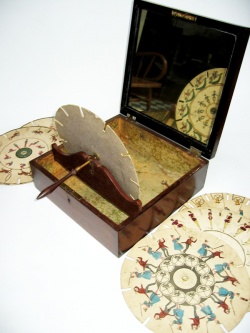
A later version, which eliminated the need for a mirror, had two discs fixed at a distance on the same axis, one with slots and the other (changeable) with pictures. Some sets were designed as table models on wooden stands, with a handle to drive the discs by pulleys.
Zoetrope
The Zoetrope was invented by William George Horner in 1834. He named his device Daedalum or 'wheel of the devil'. This optical toy was forgotten for about 30 years until it was discovered and almost simultaneously patented in 1867 by William F. Lincoln, USA and in England by Milton Bradley. It was from Lincoln that the device received its new name Zoetrope, meaning 'wheel of life' from the Greek word 'zoo' for animal life and 'trope' for 'things that turn'.
Horner's Zoetrope was an adaptation of the principles of the Phenakistoscope. However it was more convenient than Plateau and Stampfer's inventions in that it eliminated the need for a mirror and allowed several people to view the motion at one time. It was constructed of an open-top drum into which was placed a hand drawn sequence of pictures on a strip of paper facing inwards. The outside of the drum had slits cut into the cylindrical surface. When the drum was spun on a central axis, the images could be viewed through the slits giving rise to the illusion of movement.
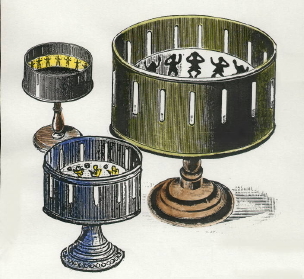

a short video, always better than words
Praxinoscope
In 1877, Frenchman Charles Émile Reynaud, refined the principle of the Zoetrope to use reflected light creating the Praxinoscope (patented December 1877). This was the first device to overcome the blurred distortion caused by viewing through narrow fast moving slots and it quickly replaced the Zoetrope in popularity. Like the Zoetrope, a paper strip of pictures is placed inside a shallow outer cylinder, so that each picture is reflected by the inner set of mirrors. The number of mirror facets equaled the number of pictures on the paper strip. When the outer cylinder rotates, the quick succession of images reflected in the mirrors gives the illusion of movement. This produced a image that was more brilliant and sharper than with any previous device.
Reynaud managed to adapt the principle behind his Praxinoscope to project a series of pictures onto a screen. 1892 in Paris, he opened the 'Theatre Optique' - the very first moving pictures shown publicly via projection onto a screen.
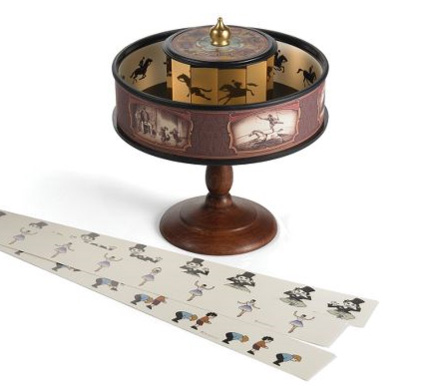
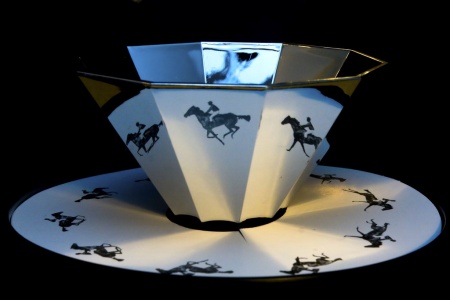
video that shows it:)
and now a useful image to get the difference :)
Technology
Recent projects
Some very few works that employ the same principles
Tim Wheatley
Tim Wheatley is an animator, thus the projects is only seen trough camera
Gregory Barsamian
quite amazing sculptural, stroboscopic works. His website design is almost as dazzling:)
Julien Maire
a 3d printed film
Scott Blake
9/11 Zoetrope by the artist
Bill Brandt
Msstransiscope - Public space artwork
Troika
digital zoetrope
Takeshi Murata
sculptural, stroboscopic optical illusion / with flawless documentation
Peter Hudson
huge scale 3d zoetropes at Burning man - this is the man
Disney's toy story 3d zoetrope
Potentially useful re-creative technology
Motors
Strobe Light
3d printing
lasercutting
Workshop documentation
...end
